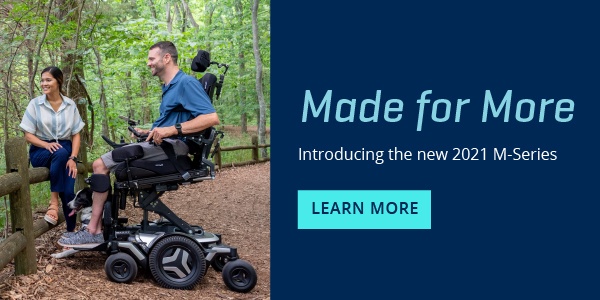What if I’m being told my client doesn’t qualify for a power wheelchair?
Work with the ATP at the equipment supplier to find out the why behind this statement. If you feel your client medically and functionally requires the use of a power wheelchair, there are several things to keep in mind:
In order to qualify for a Group 3 power wheelchair under Medicare, the individual’s mobility limitation must be due to one of the following:
- Neurologic condition
- Myopathy
- Congenital skeletal deformity (CMS, 2017)
If your client doesn’t have one of these conditions, they may still qualify for POV, Group 1 or Group 2 PWC.
|
* Always look at the client needs first and not what they qualify for. You are the client advocate and can document why your client needs what you are requesting. It’s not always easy, but we need to do all we can to ensure our clients have the opportunity to be the best that they can be! |
How does my client qualify for tilt and recline?
Under Medicare guidelines, the coverage criteria for tilt and recline are the same. In order to qualify for tilt, recline, or tilt and recline, at least one of the following must be met:
- The individual is at high risk for development of a pressure injury and is unable to adequately relieve pressure without the recommended power seat function; OR
- The individual uses intermittent catheterization for bladder management and is unable to transfer out of the chair to do so; OR
- The power seat function(s) is required to manage increased tone or spasticity (CMS, 2018)
If your client has a funding source other than Medicare and has a need that falls outside of the above listed criteria, he or she may qualify.
How does my client qualify for elevating legrests?
Under Medicare guidelines, in order to qualify for elevating legrests, at least one of the following must be met:
- The individual has a musculoskeletal condition, cast, or brace which prevents the ability to achieve 90 degrees of flexion at the knee; OR
- The presence of significant edema in the lower extremity(ies) requiring elevating legrests; OR
- The individual meets the criteria for and has a reclining backrest on the wheelchair (CMS, 2018)
If your client has a funding source other than Medicare and has a need that falls outside of the above listed criteria, he or she may qualify.
I’ve heard the standing power seat function is never covered by insurance, is that true?
NO. There are funding sources that will pay for the standing power seat function. For example, some state Medicaid programs, private insurances, and vocational rehabilitation programs may pay given sufficient medical and functional need.
This goes back to the clinician being the advocate for the client and recommending what is medically and functionally necessary – regardless of what you are being told has been covered in the past.
It is important to keep in mind that when recommending a standing power seat function, expect the need for an appeal or two – it may be denied initially – but don’t let that discourage you!
Can my client pay for components out of pocket if they choose to do so?
It depends on the funding source, but often the answer is "yes." This is a good conversation to have with your wheelchair manufacturer’s rep or equipment supplier.
In a survey done in conjunction with PatientsLikeMe with individuals with ALS, MS, and SCI, 77% of respondents reported they would want to be shown features even if that feature was not going to be covered by insurance. When asked why, the top answers included:
- To understand the options available
- I am or might be willing to pay myself
- To have autonomy over the purchase
- To see features that might improve my quality of life
- I may be able to find other funding sources (Online survey, 2018)
These are a few common funding questions asked about power wheelchairs. The list of resources below might also be able to help with funding when needed.
General:- Assistive Technology Funding Resource Guide
- Permobil Foundation
- Vocational Rehabilitation Services
- eSpecial Needs Funding Resource Links
Permobil’s funding team can answer any funding questions and can be reached by email at Jim.Stephenson@permobil.com.
 Stacey Mullis, OTR/ATP
Stacey Mullis, OTR/ATP
Director of Clinical Marketing
Stacey serves as Director of Clinical Marketing for Permobil. A practicing OTR for over 20 years, she has experience in school-based pediatrics, inpatient rehabilitation, long term care, and home health. With her interest in wheelchair seating and positioning, Stacey engaged the challenges of providing appropriate seating in various clinical settings. She now uses this experience to develop programs and resources to educate clinicians on the principles of seating and wheeled mobility. She is passionate about equipping clinicians and through her previous role as Director of Clinical Education with Comfort Company and now with Permobil she has taught nationally and internationally to increase therapist capacity in this specialty area. Mullis graduated from Western University in London, Ontario, Canada with a BA Linguistics and BSc Occupational Therapy. She is a member of the NCOTA, CTF Executive Board, NRRTs, RESNA, and AOTA.
 Angela Regier, OTD, OTR/L, ATP/SMS
Angela Regier, OTD, OTR/L, ATP/SMS
Clinical Education Manager
Angela Regier, OTD, OTR/L, ATP received her doctorate of occupational therapy from Creighton University in 2007 and is a RESNA-certified assistive technology professional. Regier joined Permobil in 2017 as a Clinical Education Manager for the western region. Prior to joining Permobil, Regier was at Craig Hospital in Englewood, Colorado where her career focused on inpatient and outpatient spinal cord injury rehabilitation. Prior to leaving Craig Hospital, she was supervisor of the Wheelchair Seating and Mobility Clinic where she provided comprehensive seating and mobility interventions for individuals with acquired brain and spinal cord injury. Regier has published and speaks on the topic of seating and mobility for acquired brain injury and spinal cord injury. She has also served as an adjunct faculty for the Creighton University Entry-Level Distance OTD Program (Regis) in Denver, Colorado.

